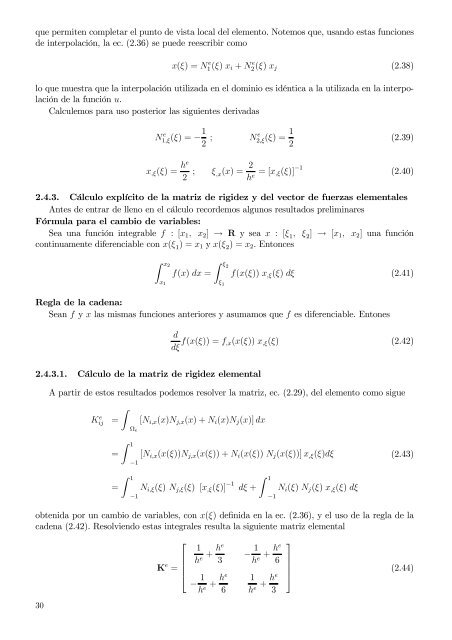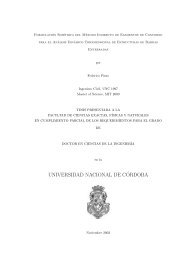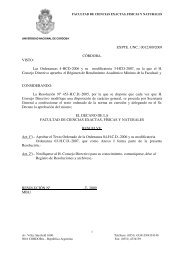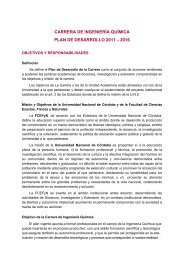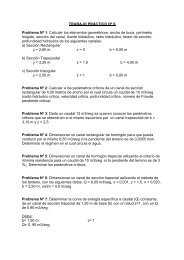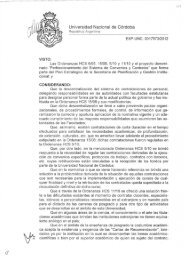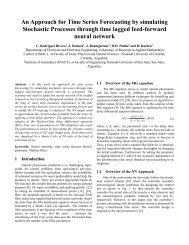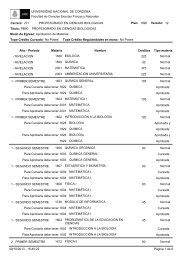Capítulo 1 Métodos de residuos ponderados Funciones de prueba ...
Capítulo 1 Métodos de residuos ponderados Funciones de prueba ...
Capítulo 1 Métodos de residuos ponderados Funciones de prueba ...
You also want an ePaper? Increase the reach of your titles
YUMPU automatically turns print PDFs into web optimized ePapers that Google loves.
que permiten completar el punto <strong>de</strong> vista local <strong>de</strong>l elemento. Notemos que, usando estas funciones<br />
<strong>de</strong> interpolación, la ec. (2.36) se pue<strong>de</strong> reescribir como<br />
x(ξ) = N e 1 (ξ) x i + N e 2 (ξ) x j (2.38)<br />
lo que muestra que la interpolación utilizada en el dominio es idéntica a la utilizada en la interpolación<br />
<strong>de</strong> la función u.<br />
Calculemos para uso posterior las siguientes <strong>de</strong>rivadas<br />
N e 1,ξ(ξ) = − 1 2 ; N e 2,ξ(ξ) = 1 2<br />
(2.39)<br />
x ,ξ (ξ) = he<br />
2 ; ξ ,x(x) = 2 h e = [x ,ξ(ξ)] −1 (2.40)<br />
2.4.3. Cálculo explícito <strong>de</strong> la matriz <strong>de</strong> rigi<strong>de</strong>z y <strong>de</strong>l vector <strong>de</strong> fuerzas elementales<br />
Antes <strong>de</strong> entrar <strong>de</strong> lleno en el cálculo recor<strong>de</strong>mos algunos resultados preliminares<br />
Fórmula para el cambio <strong>de</strong> variables:<br />
Sea una función integrable f : [x 1 , x 2 ] → R y sea x : [ξ 1 , ξ 2 ] → [x 1 , x 2 ] una función<br />
continuamente diferenciable con x(ξ 1 ) = x 1 y x(ξ 2 ) = x 2 . Entonces<br />
∫ x2<br />
∫ ξ2<br />
f(x) dx = f(x(ξ)) x ,ξ (ξ) dξ (2.41)<br />
x 1 ξ 1<br />
Regla <strong>de</strong> la ca<strong>de</strong>na:<br />
Sean f y x las mismas funciones anteriores y asumamos que f es diferenciable. Entones<br />
d<br />
dξ f(x(ξ)) = f ,x(x(ξ)) x ,ξ (ξ) (2.42)<br />
2.4.3.1. Cálculo <strong>de</strong> la matriz <strong>de</strong> rigi<strong>de</strong>z elemental<br />
A partir <strong>de</strong> estos resultados po<strong>de</strong>mos resolver la matriz, ec. (2.29), <strong>de</strong>l elemento como sigue<br />
∫<br />
Kij e = [N i,x (x)N j,x (x) + N i (x)N j (x)] dx<br />
Ω e<br />
=<br />
∫ 1<br />
[N i,x (x(ξ))N j,x (x(ξ)) + N i (x(ξ)) N j (x(ξ))] x ,ξ (ξ)dξ<br />
−1<br />
(2.43)<br />
=<br />
∫ 1 ∫ 1<br />
N i,ξ (ξ) N j,ξ (ξ) [x ,ξ (ξ)] −1 dξ + N i (ξ) N j (ξ) x ,ξ (ξ) dξ<br />
−1<br />
−1<br />
obtenida por un cambio <strong>de</strong> variables, con x(ξ) <strong>de</strong>finida en la ec. (2.36), y el uso <strong>de</strong> la regla <strong>de</strong> la<br />
ca<strong>de</strong>na (2.42). Resolviendo estas integrales resulta la siguiente matriz elemental<br />
30<br />
⎡<br />
K e = ⎢<br />
⎣<br />
1<br />
h + he<br />
e 3<br />
− 1 h e + he<br />
6<br />
− 1 h e + he<br />
6<br />
1<br />
h + he<br />
e 3<br />
⎤<br />
⎥<br />
⎦<br />
(2.44)


